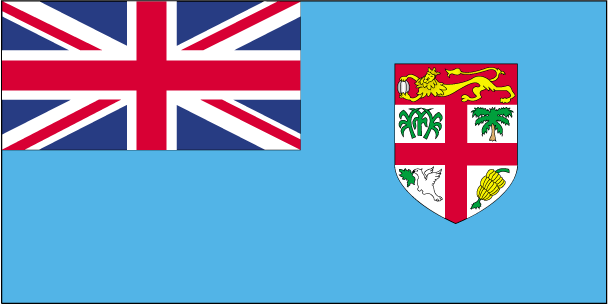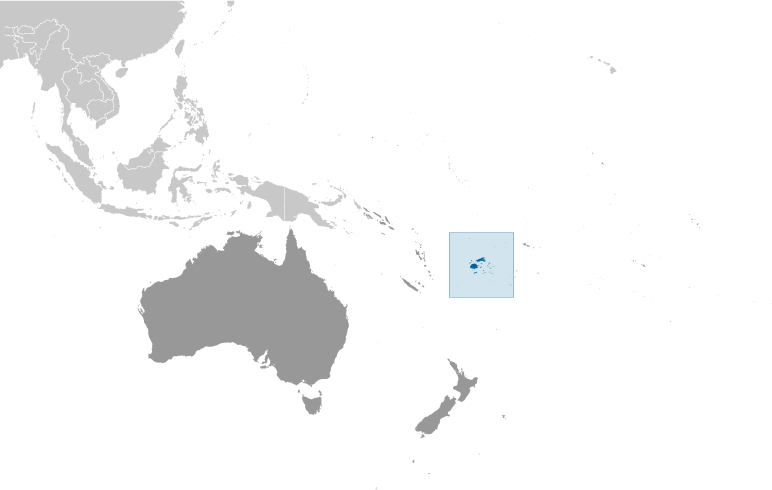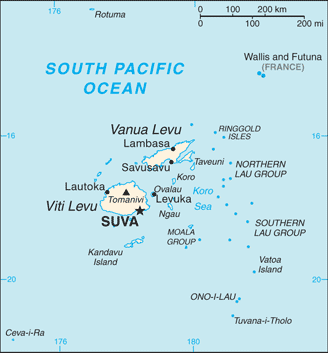
|
|
Advertisements:
EconomyEconomy - overview
Fiji, endowed with forest, mineral, and fish resources, is one of the most developed of the Pacific island economies though still with a large subsistence sector. Sugar exports, remittances from Fijians working abroad, and a growing tourist industry - with 400,000 to 500,000 tourists annually - are the major sources of foreign exchange. Fiji's sugar has special access to European Union markets but will be harmed by the EU's decision to cut sugar subsidies. Sugar processing makes up one-third of industrial activity but is not efficient. Fiji's tourism industry was damaged by the December 2006 coup and is facing an uncertain recovery time. In 2007 tourist arrivals were down almost 6%, with substantial job losses in the service sector, and GDP dipped. The coup has created a difficult business climate. The EU has suspended all aid until the interim government takes steps toward new elections. Long-term problems include low investment, uncertain land ownership rights, and the government's inability to manage its budget. Overseas remittances from Fijians working in Kuwait and Iraq have decreased significantly. Fiji's current account deficit peaked at 23% of GDP in 2006, and has been improving since that year. Gdp (purchasing power parity) World Ranking: 171
$4.186 billion (2011 est.)
$4.106 billion (2010 est.) $4.112 billion (2009 est.) Note Data are in 2011 US dollars Gdp (official exchange rate)
$3.546 billion (2011 est.)
Gdp - real growth rate World Ranking: 145
2% (2011 est.)
-0.2% (2010 est.) -1.3% (2009 est.) Gdp - per capita (ppp) World Ranking: 157
$4,700 (2011 est.)
$4,600 (2010 est.) $4,700 (2009 est.) Note Data are in 2011 US dollars Gdp - composition by sector
Agriculture 12%
Industry 20.2% Services 67.7% (2011 est.) Labor force World Ranking: 162
335,000 (2007 est.)
Labor force - by occupation
Agriculture 70%
Industry and services 30% (2001 est.) Unemployment rate World Ranking: 88
7.6% (1999)
Population below poverty line
31% (2009 est.)
Household income or consumption by percentage share
Lowest 10% 2.6%
Highest 10% 34.9% Budget
Revenues $948 million
Expenditures $1.06 billion (2011 est.) Taxes and other revenues World Ranking: 117
26.7% of GDP (2011 est.)
Budget surplus (+) or deficit (-) World Ranking: 103
-3.1% of GDP (2011 est.)
Public debt World Ranking: 58
48.8% of GDP
54.5% of GDP Inflation rate (consumer prices) World Ranking: 184
8.7% (2011 est.)
5.5% (2010 est.) Central bank discount rate World Ranking: 105
1.75% (31 December 2010 est.)
3% (31 December 2009 est.) Commercial bank prime lending rate World Ranking: 127
7.47% (31 December 2011 est.)
7.5% (31 December 2010 est.) Stock of narrow money World Ranking: 145
$1.099 billion (31 December 2011 est.) $780.3 million (31 December 2010 est.) Stock of broad money World Ranking: 145
$2.495 billion (31 December 2011 est.) $1.89 billion (31 December 2010 est.) Stock of domestic credit World Ranking: 139
$1.758 billion (31 December 2011 est.) $1.783 billion (31 December 2010 est.) Market value of publicly traded shares World Ranking: 102
$1.372 billion (31 December 2011) $1.404 billion (31 December 2010) $1.607 billion (31 December 2009) Agriculture - products
Sugarcane, coconuts, cassava (manioc), rice, sweet potatoes, bananas; cattle, pigs, horses, goats; fish Industries
Tourism, sugar, clothing, copra, gold, silver, lumber, small cottage industries Industrial production growth rate
NA%
Electricity - production World Ranking: 145
970 million kWh (2009 est.)
Electricity - consumption World Ranking: 147
865.8 million kWh (2008 est.)
Electricity - exports
0 kWh (2009 est.)
Electricity - imports
0 kWh (2009 est.)
Oil - production World Ranking: 172
0 bbl/day (2010 est.)
Oil - consumption World Ranking: 140
15,000 bbl/day (2010 est.)
Oil - exports World Ranking: 112
1,857 bbl/day (2009 est.)
Oil - imports World Ranking: 114
18,850 bbl/day (2009 est.)
Oil - proved reserves World Ranking: 130
0 bbl (1 January 2011 est.)
Natural gas - production World Ranking: 180
0 cu m (2009 est.)
Natural gas - consumption World Ranking: 176
0 cu m (2009 est.)
Natural gas - exports World Ranking: 97
0 cu m (2009 est.)
Natural gas - imports World Ranking: 191
0 cu m (2009 est.)
Natural gas - proved reserves World Ranking: 176
0 cu m (1 January 2011 est.)
Current account balance World Ranking: 102
-$428.8 million (2011 est.)
-$416 million (2010 est.) Exports World Ranking: 160
$901.5 million (2011 est.)
$819.5 million (2010 est.) Exports - commodities
Sugar, garments, gold, timber, fish, molasses, coconut oil Exports - partners
Australia 14.3%, US 11%, Japan 6.3%, UK 5.9%, Samoa 5.8%, Tonga 5.1% (2011) Imports World Ranking: 161
$1.762 billion (2011 est.)
$1.602 billion Imports - commodities
Manufactured goods, machinery and transport equipment, petroleum products, food, chemicals Imports - partners
Singapore 34.1%, Australia 16.3%, NZ 14.1%, China 8.9% (2011) Reserves of foreign exchange and gold World Ranking: 135
$833.5 million (31 December 2011 est.) $720.6 millionDebt - external World Ranking: 180
$258.7 million (31 December 2011 est.) $251 millionStock of direct foreign investment - at home
$NA
Stock of direct foreign investment - abroad
$NA
Exchange rates
Fijian dollars (FJD) per US dollar - 1.7932 (2011 est.)1.9183 (2010 est.) Fiscal year
Calendar year
Comments
Add a new comment: |
Advertisement
Members area
Fiji (Suva):
 
GPS points from Fiji (Suva)
|
||||||||

 Fiji became independent in 1970 after nearly a century as a British colony. Democratic rule was interrupted by two military coups in 1987 caused by concern over a government perceived as dominated by the Indian community (descendants of contract laborers brought to the islands by the British in the 19th century). The coups and a 1990 constitution that cemented native Melanesian control of Fiji led to heavy Indian emigration; the population loss resulted in economic difficulties, but ensured that Melanesians became the majority. A new constitution enacted in 1997 was more equitable. Free and peaceful elections in 1999 resulted in a government led by an Indo-Fijian, but a civilian-led coup in May 2000 ushered in a prolonged period of political turmoil. Parliamentary elections held in August 2001 provided Fiji with a democratically elected government led by Prime Minister Laisenia QARASE. Re-elected in May 2006, QARASE was ousted in a December 2006 military coup led by Commodore Voreqe BAINIMARAMA, who initially appointed himself acting president but in January 2007 became interim prime minister. Since taking power BAINIMARAMA has neutralized his opponents, crippled Fiji's democratic institutions, and refused to hold elections.
Fiji became independent in 1970 after nearly a century as a British colony. Democratic rule was interrupted by two military coups in 1987 caused by concern over a government perceived as dominated by the Indian community (descendants of contract laborers brought to the islands by the British in the 19th century). The coups and a 1990 constitution that cemented native Melanesian control of Fiji led to heavy Indian emigration; the population loss resulted in economic difficulties, but ensured that Melanesians became the majority. A new constitution enacted in 1997 was more equitable. Free and peaceful elections in 1999 resulted in a government led by an Indo-Fijian, but a civilian-led coup in May 2000 ushered in a prolonged period of political turmoil. Parliamentary elections held in August 2001 provided Fiji with a democratically elected government led by Prime Minister Laisenia QARASE. Re-elected in May 2006, QARASE was ousted in a December 2006 military coup led by Commodore Voreqe BAINIMARAMA, who initially appointed himself acting president but in January 2007 became interim prime minister. Since taking power BAINIMARAMA has neutralized his opponents, crippled Fiji's democratic institutions, and refused to hold elections.